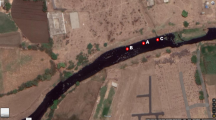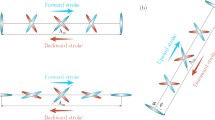Abstract
Aiming to improve the pull-up control performance in the process of releasing balloon-borne solar powered UAVs (Unmanned Aerial Vehicles), this paper establishes the full flight mechanics equations with flexible modes, and proposes the control method suitable for engineering application. To be specific, the authors first calculate the real aerodynamic force on horizontal stabilizer by comparing the fuselage deformation in ballooning test with that in static loading test. Furthermore, considering fuselage elastic deformation, the pitching moment coefficient is obtained and the influence of airspeed and elevator angle on pitching moment coefficient and control surface efficiency are analysed. Second, the authors establish a complete flight mechanics model, including elastic structural dynamic model and rigid flight dynamic model, by comprehensively considering the aerodynamic data, the relationship between fuselage deformation and load, as well as the ballooning test. Third, the authors perform the numerical simulation and comparison study on control performance between rigid model and flexible model. Moreover, the authors implement model modification based on the low altitude flight test and steady-state point analysing. Finally, a scaled UAV is used to complete the balloon-borne launching test. The results show that the longitudinal control method can analyse the longitudinal aerodynamics and control characteristics accurately, and could be effectively utilized in the pull-up control of the balloon-borne solar powered UAV.
Similar content being viewed by others
References
Li C F and Jiang L H, Research status and key technology of near space long endurance high altitude solar-powered unmanned air vehicle, China Basic Science, 2018, 20(2): 22–31.
Ma D L, Zhang L, Yang M Q, et al., Review of key technologies of ultra-long-endurance solar powered unmanned aerial vehicle, Acta Aeronautica et Astronautica Sinica, 2020, 41(3): 29–58.
Elson A C, Unmanned aerial vehicle and method of launching, Patent Application Publication, 2014, US2014/0021288A1.
Tao Y J, Development and key technology on near space long voyage solar unmanned aerial vehicle, Aeronautical Manufacturing Technology, 2016, (18): 26–30.
He W, Yan Z C, Sun C Y, et al., Adaptive neural network control of a flapping wing micro aerial vehicle with disturbance observer, IEEE Transactions on Cybernetics, 2017, 47(10): 3452–3465.
Yang F, Tan S P, Xue W C, et al., Extended state filtering with saturation-constrainted observations and active disturbance rejection control of position and attitude for drag-free satellites, Acta Automatica Sinica, 2020, 46(11): 2337–2349.
Tan S P, Guo J, Zhao Y L, et al., Adaptive control with saturation-constrainted observations for drag-free satellites — A set-valued identification approach, SCIENCE CHINA Informations, 2021, 64, 202202:1–202202:12.
Chen J, Wang J Y, and Wang W H, Robust adaptive control for nonlinear aircraft system with uncertainties, Applied Sciences, 2020, 10(12): 1–16.
Zhang J, Yan J, Yang L, et al., Robust IFNTSM-ESO control design for aircraft subject to parameter uncertainties, International Journal of Aeronautical and Space Sciences, 2020, 21(1): 239–250.
Jiao X, Baris, Jiang J, et al., Type-2 fuzzy adaptive sliding mode control of hypersonic flight, Journal of Aerospace Engineering, 2019, 233(8): 2731–2744.
Zhao H, Zhu Z C, and Sun H, Adaptive robust control and optimal design for fuzzy unmanned helicopter tail reduction, International Journal of Fuzzy Systems, 2020, DOI: https://doi.org/10.1007/s40815-020-00870-5.
Peng C, Ma J J, and Yao J S, Adaptive output feedback control for a highly flexible aircraft with direct feedthrough term, 2020 Chinese Control and Decision Conference, 2020, 7: 159–165.
Zhang J X and Wu J, Nonlinear aeroelastic response of high-aspect-ratio flexible wings, Chinese Journal of Aeronautics, 2009, 22(4): 355–363.
Guo Q F, He X, Wang Z, et al., Effects of wing flexibility on aerodynamic performance of an aircraft model, Chinese Journal of Aeronautics, 2021, 34(9): 133–142.
Brijesh R and Mayuresh J P, Flight control for flexible, high-aspect-ratio flying wings, Journal of Guidance, Control, and Dynamics, 2010, 33(1): 64–74.
Silvestre, Flávio J, Guimares N A B, et al., Aircraft control based on flexible aircraft dynamics, Journal of Aircraft, 2017, 54(1): 262–271.
Ma Z Y, Zhu X P, and Zhou Z, A lateral-directional control method combining rudder and propeller for full-wing solar-powered UAV, Acta Aeronautica et Astronautica Sinica, 2018, 39(3): 210–220.
Wang R, Zhu X P, and Zhou Z, Longitudinal stability and control of highly flexible solar-powered UAV, Journal of Northwestern Polytechnical University, 2015, 33(4): 573–579.
Feng Y F, Zhou Z, and Xiao W, Study on longitudinal flight dynamic characteristics of high altitude flexibility solar powered UAV, Flight Dynamics, 2014, 32(1): 3–6.
Wang W, Zhou Z, and Zhu X P, CR approach of nonlinear trim and flight load analysis of very flexible solar powered UAV, Journal of Northwestern Polytechnical University, 2015, 33(4): 566–572.
Li F, Ye C, Li G J, et al., Lateral-directional stability of near-space solar-powered aircraft, Acta Aeronautica et Astronautica Sinica, 2016, 37(4): 1148–1158.
Li F, Bai P, and Ye C, Study about key dynamic problems of near space solar power aircraft, Sci. Sin. — Phys. Mech. Astron., 2015, 45(12): 73–83.
Kampoon J, Jiajan W, and Klongtrujrok J, Aerodynamics, stability and control analysis of tactical solar power UAV, IOP Conference Series: Materials Science and Engineering, 2020, 886(1): 1–11.
Fang Z P, Chen W C, and Zhang S G, Flight Dynamics of Aircraft, Bei Hang University Press, Beijing, 2005, 288–302.
Jan R W and Jonathan E C, Introduction to Aircraft Aeroelasticity and Loads, Second Edition, John Wiley and Sons Ltd, New Jersey, 2015, 267–272, 279–285.
Wang W, Exploring nonlinear aeroelastic and flight dynamics of solar-powered UAV, Northwestern Polytechnical University, 2015, 117–150.
Meng B and Zhao Y B, The dynamics characteristics of flexible spacecraft and its closed-loop stability with passive control, Journal of Systems Science & Complexity, 2021, 34(3): 860–872.
Ranjan V, Flight Dynamics, Simulation, and Control: For Rigid and Flexible Aircraft, CRC Press, 2015, 403–435.
Zhang D, Tang S, Zhu Q J, et al., Analysis of dynamic characteristics of the rigid body/elastic body coupling of air-breathing hypersonic vehicles, Aerospace Science and Technology, 2016, 48: 328–341.
Wu G H, Meng X Y, and Wang F Y, Improved nonlinear dynamic inversion control for a flexible air-breathing hypersonic vehicle, Aerospace Science and Technology, 2018, 78: 734–743.
Hu Y P, Yang Y P, Ma X P, et al., Computational optimal launching control for balloon-borne solar-powered unmanned aerial vehicles in near-space, Science Progress, 2019, 103(1): 1–19.
Author information
Authors and Affiliations
Corresponding author
Additional information
This research was supported by the Beijing Natural Science Foundation under Grant No. 4222050 and the National Natural Science Foundation of China under Grant No. 62173030.
This paper was recommended for publication by Editor SUN Jian.
Rights and permissions
About this article
Cite this article
Hu, Y., Guo, J., Meng, W. et al. Longitudinal Control for Balloon-Borne Launched Solar Powered UAVs in Near-Space. J Syst Sci Complex 35, 802–819 (2022). https://doi.org/10.1007/s11424-022-1302-6
Received:
Revised:
Published:
Issue Date:
DOI: https://doi.org/10.1007/s11424-022-1302-6




